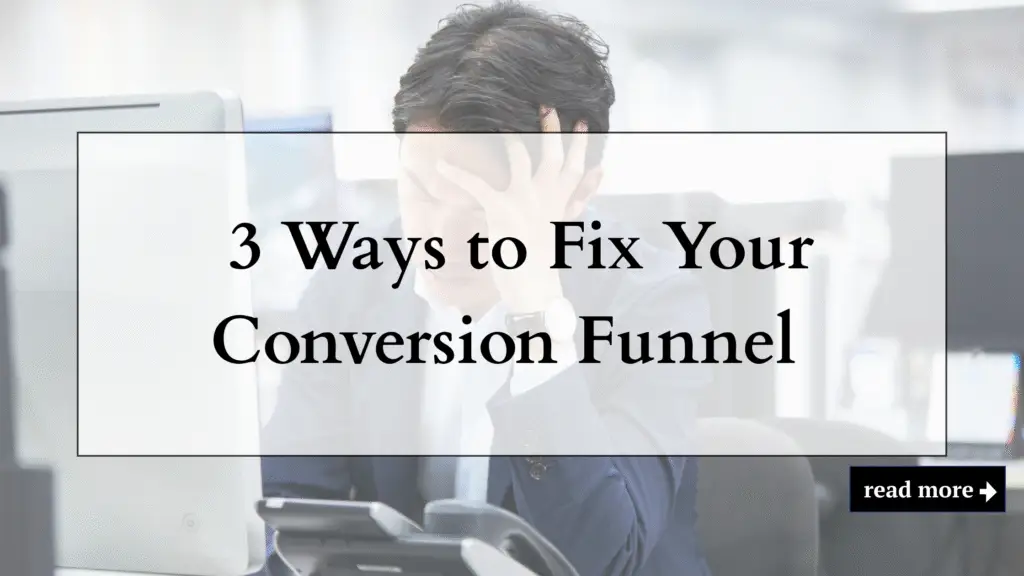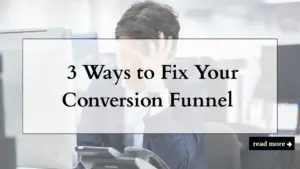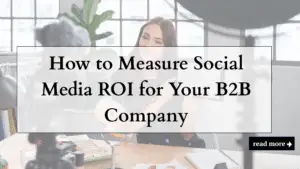Do you know that your website is like a Leaky Bucket? We will tell you the 3 most common ways to fix your conversion funnel.
Why Your Conversion Funnel Is Costing You Leads — And How to Fix It
A strong conversion funnel is essential for any successful online business, particularly in the B2B sector. If your website acts like a “leaky bucket,” it means you are losing valuable visitors before they turn into customers. These missed chances often occur due to issues at various stages of the conversion funnel. Identifying and resolving these issues is the first step toward improving your digital marketing strategy for long-term growth.
What’s a Leaky Funnel — and Why It’s Hurting Your Conversions
A conversion funnel maps the journey from first click to final action. It’s typically divided into three key stages:
- Top of Funnel (TOFU): Attracts your target audience
- Middle of Funnel (MOFU): Builds trust and educates prospects
- Bottom of Funnel (BOFU): Drives conversions and sales.
The Exact Points Where Your Funnel Is Losing Customers
When your conversion funnel leaks, potential customers drop off before taking action.
To find the problem, you need more than click data. Use tools like:
- Session replays
- Path analysis
- On-site surveys
These insights help pinpoint where users abandon the funnel.
Why B2B Funnels Fail: The Hidden Gaps in IT & Consulting Journeys
In B2B industries, such as managed IT and consulting, the conversion funnel is more complex. Deals involve multiple stakeholders and longer sales cycles.
Most drop-offs happen in the middle of the funnel, where leads require nurturing.
Common issues include:
- Poor lead qualification
- Inefficient routing
- Outdated CRM data
All of these slow down your sales team and reduce ROI.
Quick Fix: Patch Your Funnel with Smarter Lead Prioritization
To improve your conversion funnel, start by cleaning CRM data and tightening lead prioritization.
Are You Hitting the Right Benchmarks? What Your Conversion Rate Really Means
Before you can improve, you need to know where you stand. Every successful conversion funnel strategy starts with a benchmark.
Across all industries, the average website conversion rate is 3.68%. However, in specialized B2B sectors—such as legal, IT, or consulting—those numbers are often significantly lower.
B2B Industry Conversion Benchmarks
Here’s how different industries perform at key stages of the conversion funnel:
| Industry | Avg. Conversion Rate | Funnel Focus | Key Metric |
|---|---|---|---|
| Legal Services | 7.40% | Service Inquiry (BOFU) | MQL Conversion Rate |
| Real Estate | 2.80% | Lead Generation / Consultation | Avg. Session Duration |
| IT & Managed Services | 1.50% | Demo Request (MOFU) | SQL Conversion Rate |
| PPC Landing Pages (Top 10%) | 11.45% | Immediate Action | Click-Through Rate (CTR) |
The Cost of Mid-Funnel Leaks in High-Stakes B2B Deals
If you’re in IT, consulting, or a B2B niche, your conversion funnel may struggle during the middle stage—where qualification and demos happen.
This makes every lost lead more expensive. That’s why even minor improvements in your conversion rate can lead to significant ROI gains.
Why MOFU Optimization Is the Secret Weapon for B2B Growth
In the IT & Managed Services industry, the average conversion rate is just 1.5%. That’s because buyers in this space are making high-trust, high-commitment decisions. They’re careful, and the conversion funnel must reflect that.
Instead of focusing solely on the final step (BOFU), most CRO efforts should target the middle of the funnel (MOFU) — where lead qualification and nurturing typically occur.
Don’t Settle for Average: Target Elite Conversion Rates
Great digital agencies don’t settle for “average.” The top 10% of PPC landing pages convert at a rate of 11.45% or higher. How? By aligning their conversion funnel with buyer intent.
This includes:
- Using high-intent keywords in BOFU content
- Supporting them with educational TOFU & MOFU resources (like this blog post)
- Matching messaging across every funnel stage
Align Your Funnel and Clean Your CRM for Higher Conversions
To fully optimize the conversion funnel, your content must be aligned with the buyer journey — and your CRM data must be clean and current.
This combination drives smarter decisions and better ROI.
Fix One: Strengthen the Technical Foundation
Why Site Performance Impacts Your Conversion Funnel
Technical performance isn’t just for SEO—it directly affects how well your conversion funnel works. A slow website silently leaks potential customers before your message even loads.
Site Speed = More Conversions
Site speed has a significant effect on conversion. For example:
A site that loads in 1 second converts 3x more than one that loads in 5 seconds
If it takes 10 seconds, conversion drops 5x
Even a 1-second improvement can boost conversions by 2%. On mobile, a 1-second delay can cut conversions by 20%.
Clearly, fixing speed issues should be a top priority in your conversion funnel strategy.
Core Web Vitals and Interactivity
Google’s Core Web Vitals now affect rankings and real-world UX. The key metrics:
- LCP: How fast does your content load
- CLS: How stable your layout is
- INP: How quickly your site responds to clicks and actions
INP matters most for B2B conversion funnels that rely on lead forms, demos, or interactive elements. A slow, frustrating experience here can kill your conversion.
Mobile UX = ROI Multiplier
Almost 60% of traffic is generated by mobile devices. If your site isn’t mobile-optimized, you’re losing leads.
Just 1 second of delay on mobile reduces conversions by up to 20%.
UX matters too. Research shows:
- $1 invested in UX = $100 ROI
- A clean, frictionless design can improve conversion by up to 400%
That makes technical fixes a high-leverage investment in your conversion funnel performance.
Fix Two: Build Trust with Social Proof
Social Proof Converts
B2B buyers are cautious. They want proof.
- 93% read reviews before buying
- Products with reviews are 270% more likely to be purchased
- Video testimonials boost conversion by up to 80%
Add genuine reviews near CTAs, pricing pages, and service details. Prioritize authenticity—4.2 to 4.5 stars are often more trusted than a perfect 5.0.
Trust Badges and Guarantees
Security matters at checkout. Visual trust signals like:
- SSL badges
- PayPal / Visa / Mastercard logos
Can improve conversions by up to 32%, and reduce cart abandonment by 20%.
Also, clear refund or guarantee policies minimize risk and increase BOFU conversions.
Your conversion funnel needs to remove anxiety—not just attract attention.
Quick Stats – Trust Signals That Drive Results
| Trust Signal | Conversion Impact | Why It Works |
|---|---|---|
| Personalized CTAs | +202% | Aligns with buyer journey |
| Reviews (vs. none) | +270% purchase likelihood | Adds credibility |
| Payment logos | +81% | Increases perceived security |
| Video Testimonials | +80% | Builds authenticity |
| SSL Badges | +42% | Reduces checkout friction |
Fix Three: Personalization & A/B Testing
Personalization = Better Conversions
Generic CTAs no longer suffice. Personalized CTAs convert:
- 202% better than generic ones
- 42% more if tailored to industry or interests
For example:
Visitors searching for “best outsourced lead generation” should see
“Book Your Custom Strategy Session”
instead of “Subscribe to Our Newsletter.”
The right message, at the right stage, powers your conversion funnel.
Shorter Forms = More Leads
Long forms kill conversions. Research shows:
- 3 fields is the sweet spot
- More than that = friction
Use progressive profiling: collect the basics first (name, email), then nurture and qualify deeper later. This improves both the quantity and quality of leads.
Test Everything: A/B for Growth
Conversion Rate Optimization (CRO) is a scientific approach to improving website performance. A/B testing helps you find what actually works. Start with:
- Headlines
- CTA copy
- Page layouts
- Value propositions
Follow the “One Change Rule” — test only one variable at a time. This gives you real insights, not assumptions.
A/B testing is crucial for optimizing the conversion funnel from click to close.
Final Thoughts: Fix the Funnel, Grow the Business
To fix a leaky conversion funnel, you need a complete strategy—not just prettier pages.
Fix 1: Technical Foundation
Improve speed, mobile UX, and Core Web Vitals. Faster sites = better ROI.
Fix 2: Trust Signals
Use testimonials, badges, reviews, and guarantees to reduce friction.
Fix 3: Precision Targeting
Personalize content and CTAs. Shorten forms. A/B test continuously.
In industries such as IT or Managed Services, where conversion rates typically hover around 1.5%, these three fixes can unlock meaningful growth and ROI.



